 |
 |
|
|
The P-C 557 Other Impressions This wide opening also makes it inferior when positioning slots closely to the edge on outside corners. The fence isn't so stiff that when a corner falls into the opening, the weight of the machine doesn't cause the slot to go in at a slight angle. Plan on centering even smaller biscuits at least 1 3/4" from any edge to get the proper support. Fortunately Porter-Cable gives you an accessory you can slip over the fence much like the spacer which comes with Lamello machines. This slip-on plastic alignment plate is clear and has handy outside indexing marks to outline edges when cutting smaller slots. If you buy the P-C 557 for it's narrow stock capabilities and do woodworking for a living, order a second one of these plastic plates when you get your machine. From experience with Lamello machines it's safe to say it won't stand up too long to the rigors of commercial woodworking. You also need to remove it for any interior "T" joints as the fence won't fold flat while the plastic alignment plate is in position. Gauge Blocks Lately biscuit machines have evolved into sophisticated adjustment mechanisms providing a wide array of possibilities. For the most part these advances don't sacrifice any of the older functionality with the possible exception of the 557. There are three reasons for continuing the use of gauge blocks with the current crop of biscuiters. If your fence has some play and doesn't lock down completely parallel to the base, a gauge block will fix it. The second reason involves quickly moving to favorite fence heights. When you find yourself returning often to the same depth, make a block so you don't have to mess with scales and the errors which can occur. The best reason for gauge blocks prepares you for the unexpected. Many times they've saved my butt when I start gluing a job and realize I missed a slot. No big deal if I haven't changed the fence but a real pain if I have. With glue drying on the other side of the joint, there isn't time to fuss with finding the previous position of the fence. A gauge block makes this adjustment speedy and exact.
Fortunately there is enough play in the screw to get the fence block-adjusted with a little trial and error but this woodworker doesn't like it. Much better is the DeWalt's rack and pinion mechanism which allows the fence to slide up and down easily. If someone were to buy the P-C, it's a snap to remove the adjustment screw...hint, hint.
Speed Layout - Alternatives to Marking
up Your Work For biscuit machines so equipped, it's possible to join boards 8" or less without scribbling pencil marks on the wood. For jointing wider pieces, only the interior sections need marking. Using the Virutex, I've avoided making thousands of marks over the years saving myself additional countless hours of extra sanding. It's Not All Bad This machine also makes blade changing a snap with it's removable base and shaft lock - only one wrench required. There is something under the baseplate called a 'safety lever' which is engaged when you install the small blade but nowhere in the manual could I find an explanation of what it does. I think it limits back travel of the plunging motion but don't hold me to this. And there is that thing with the little biscuits. If you're making small projects and think you can use the #FF biscuits to secure your joints, the P-C 557 with it's plastic alignment plate might just be the ticket. At least the dust escaping through the top of the machine shouldn't be too intrusive. For the rest of us, of all the machines I've looked at recently, the DeWalt gives you the most bang for the buck. Heck, I might even buy you one if you can send me an old Virutex I can use for parts...:) Respectively submitted, If you have any comments, good or bad, you can send me email. |
||
Back to the Gazette
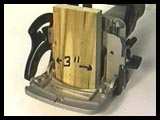 Another thing you notice about the
P-C is the huge hole in the fence. More than 3" wide, it
may give you a good line of site to your centering mark but at
a cost of complicating use with narrow boards. I like using the
Virutex fence for outside corners on stock as narrow as 2 1/2".
From the photo at left, you see this isn't gonna work with the
P-C very easily.
Another thing you notice about the
P-C is the huge hole in the fence. More than 3" wide, it
may give you a good line of site to your centering mark but at
a cost of complicating use with narrow boards. I like using the
Virutex fence for outside corners on stock as narrow as 2 1/2".
From the photo at left, you see this isn't gonna work with the
P-C very easily.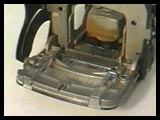
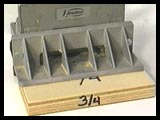 Back when I started using a biscuit
joiner, fences were rather crude affairs with lots of wiggle-room
but they were simple to comprehend and fairly inexpensive to
replace if a machine ever hit the concrete. To get my fence parallel
to the base I have to use a gauge block - loosen the fence, slide
the block underneath, press down and tighten.
Back when I started using a biscuit
joiner, fences were rather crude affairs with lots of wiggle-room
but they were simple to comprehend and fairly inexpensive to
replace if a machine ever hit the concrete. To get my fence parallel
to the base I have to use a gauge block - loosen the fence, slide
the block underneath, press down and tighten.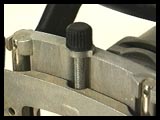 The P-C doesn't like gauge
blocks. It has a screw-adjusting knob for elevating or lowering
the fence which not only makes it slow to change, but feedback
when adjusting to a gauge isn't very responsive.
The P-C doesn't like gauge
blocks. It has a screw-adjusting knob for elevating or lowering
the fence which not only makes it slow to change, but feedback
when adjusting to a gauge isn't very responsive.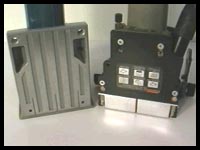 One of the advantages my Virutex has
over most biscuit machines are it's exterior indexing marks.
These marks indicate the extreme right and left ends of biscuit
slots and you can use them to place biscuits near edges without
getting out your pencil. The Virutex on the left in the picture
has easily aligned outer marks both top and bottom. The 557 has
only the center mark.
One of the advantages my Virutex has
over most biscuit machines are it's exterior indexing marks.
These marks indicate the extreme right and left ends of biscuit
slots and you can use them to place biscuits near edges without
getting out your pencil. The Virutex on the left in the picture
has easily aligned outer marks both top and bottom. The 557 has
only the center mark.